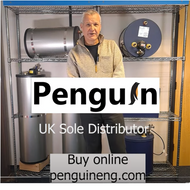ATI Marine Calorifiers - what are calorifiers and how do they work
15th Nov 2023
Penguin Engineering are the UK importers of ATI marine calorifiers from Italy. We've put together a video to give a basic overview of how calorifiers work and at the end we’ll give a quick rundown of the products. If you don’t have one on board, or if you are looking to upgrade, hopefully this will help a little with your research. See our calorifier range here
A calorifier is a glorified term for an insulated container that heats and stores fresh water, just like a traditional hot water cylinder at home.
The water can be heated in two ways. It can either transfer heat that’s been made by another source elsewhere on the boat or it heats with electricity using a built-in immersion element.
A heat source could in itself have two origins, the most typical of these being the boat’s engine. All modern engines are cooled using fresh water and the calorifier is basically an extension of the engine’s cooling system. It’s an ideal way of collecting heat because it’s working for you all the time your engine is running, without any using additional power.
The second heat source can be a diesel powered heater with a water circuit. Some yachts and most inland waterways craft have diesel powered heating systems with water pipes that deliver hot water to radiators, like most of us have at home. Again, the calorifier is an extension to the heating system, collecting some of its energy as it passes round the circuit.
These are the heat source connections. Joining them on the inside is a tubular metal heat exchanger, sometimes called a coil. It’s job is to transfer, or to exchange, the heat from the source to the water in the tank. Its shape and its large surface area are designed to make this happen as efficiently as possible. Whatever the heat source, domestic cold water from your tank comes in through the cold feed here and hot water is delivered out to your taps and showers from here.
As domestic water is used, your onboard water pump will sense the drop in pressure and automatically refill the calorifier.
As you can see, this calorifier has one pair of heat source connections. You may want to be able to heat water from two separate sources: it is useful for example to be able to heat the water with the engine while you’re on the move and to use the diesel cabin heater while you’re on the dock. In this case you’ll need a twin coil system. This for example is a 60 litre twin coil calorifier which has two pairs of heat source connections, one at each end, and two heat exchangers inside. If your boat has twin engines you choose to connect them both to a twin coil calorifier in the same way.
When it comes to electric water heating, your boat will need to be connected to shore power or a generator, although recent advances in battery and solar technologies have made generator-free water heating possible for some boats.
Under this cap is an immersion heating element and a thermostat. Our calorifiers come with 230 Volt 1250 Watt elements as standard, but we can supply 500W or 800W versions. The larger the wattage the faster the water will heat up so 1250W is the most popular size. You may however need a lower power element to work with lower rated generators, inverters or shore power hookups. If you have a boat fitted with American wiring we can supply matching 110V elements.
In a separate video we’ll provide a little more detail on these elements and thermostats, including how to replace them.
ATI offers a choice of construction materials. The ones with these blue jackets have enamelled steel interiors and enamelled heat exchangers [P8].
They are fitted with a magnesium anode inside which you need to change every year to protect against internal corrosion. The silver versions like this come at a higher price but they have stainless interiors which are much lighter in weight and they don’t have anodes. This is something to consider if your calorifier lives in a tight space where access is tricky.
Some calorifiers have their foam insulation on the outside which can be prone to damage.
With ATI, PU foam insulation is encapsulated between the outer and inner jackets. It’s easy to keep clean and keeps looking good over time.
If you are looking to replace an old unit and you’re unsure of the make, there shouldn’t be a problem with compatibility as it’s just a matter of the size and shape that work for you and your boat. ATI build calorifiers from 12 to 200 litres and they can be box shaped or cylindrical. The cylindrical versions come in two diameters, 320 or 390mm.
All of them come with a pressure relief valve and a non-return valve, which we’ll will talk about in a separate video, and they all come with a set of fitting straps.
For dimensions, pricing and more information please find us at penguineng.com or give us a call and we’ll be happy to help.

